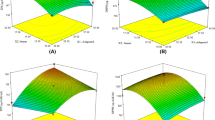Abstract
The formulation of a new functional beverage from Opuntia stricta juice enriched with whey cheese was investigated. Five beverages were developed with different percentages of juice. The storage stability was evaluated at 4 °C during 60 days in terms of physicochemical analysis (pH, acidity, total, and reducing sugar). The prepared beverages have a red color and a highly acceptable taste, the overall acceptability varies from 6.12 to 6.80 and from 7.16 to 8 respectively for the two categories of consumers 10–25 and over 25 years old. The relation between acceptability of beverages (for two categories of consumers) and sensory parameters (color, juice percentage, taste, and texture) was modelized using linear regression model with a correlation coefficient (R2) of 72.9% and 70.5% respectively for consumers 10–25 and over 25 years old. In this vein, the beverages were appreciated differently according to the age range of consumers (10–25 years or over 25 years old). A mathematical relationship between the responses (pH, acidity, reducing, and total sugars) and covariates (storage period and juice concentration) was obtained, described by first-order polynomial equations with an R2 of 87%, 83%, 89.5%, and 88.7% respectively for pH, acidity, reducing, and total sugar. The study showed that the drinkable beverage based on whey and Opuntia stricta juice with a proportion of juice varying from 35 to 25% is the best regarding sensory properties and physicochemical stability.




Similar content being viewed by others
Data availability
Data will be made available on request.
References
Ryan M, Walsh G (2016) The biotechnological potential of whey. Rev Environ Sci Biotechnol 15:479–498. https://doi.org/10.1007/s11157-016-9402-1
Guliyev R, Akgün M, SayınBörekçi B, Sadak O, Esen Y (2022) Modelling and process optimization of cheese whey wastewater treatment using magnetic nanoparticles. Biomass Conv Bioref. https://doi.org/10.1007/s13399-022-02611-0
Skryplonek K, Dmytrów I, Mituniewicz-Małek A (2019) Probiotic fermented beverages based on acid whey. J Dairy Sci 102:7773–7780. https://doi.org/10.3168/jds.2019-16385
Saglam H, Sarioglu T, Karahan AG, Oner Z (2019) An investigation for the development of whey-based probiotic beverages. Rom Biotech Lett 24(6):1097–1106. https://doi.org/10.25083/rbl/24.6/1097.1106
Panghal A, Patidar R, Jaglan S, Chhikara N, Khatkar SK, Gat Y, Sindhu N (2018) Whey valorization: current options and future scenario — a critical review. Nutr Food Sci 48(3):520–535. https://doi.org/10.1108/NFS-01-2018-0017
Buchanan D, Martindale W, Romeih E, Hebishy E (2023) Recent advances in whey processing and valorisation: technological and environmental perspectives. Int J dairy technol. https://doi.org/10.1111/1471-0307.12935
Macwan SR, Dabhi BK, Parmar S, Aparnathi K (2016) Whey and its utilization. Int J Curr Microbiol Appl Sci 5:134–155. https://doi.org/10.20546/ijcmas.2016.508.016
Da Mata RJ, Ribeiro THS, Stevanato N, Sampaio AR, Ruiz SP, Bolanho BC (2019) Effect of acaı pulp, cheese whey, and hydrolysate collagen on the characteristics of dairy beverages containing probiotic bacteria. J Food Proc Engineering 42:1–10. https://doi.org/10.1111/jfpe.12953
Mudgil D, Barak S (2019) Dairy-based functional beverages. In: Milk-based beverages (edited by A.M. Grumezescu & A.M. Holban). Pp. 67–93. Vol. 9. Cambridge: United States Woodhead Publishing
Norton V, Lignou S, Methven L (2021) Influence of age and individual differences on mouthfeel perception of whey protein-fortified products: a review. Foods 10:433. https://doi.org/10.3390/foods10020433
Nedanovska E, Jakopović KL, Daniloski D, Vaskoska R, Vasiljevic T, Barukčić I (2022) Effect of storage time on the microbial, physicochemical and sensory characteristics of ovine whey-based fruit beverages. Int J Food Sci Technol 57:5388–5398. https://doi.org/10.1111/ijfs.15870
Statista (2023) http://statista.com/outlouk/cmo/non-alcoholic-drinks/juices/worldwide consulted the 14/02/2023.
Embaby HE, Gaballah AA, Hamed YS, El-Samahy SK (2016) Physicochemical properties, bioactive compounds and sensory evaluation of Opuntia dillenii fruits mixtures. J Food Nutr Res 4(8):528–534. https://doi.org/10.12691/jfnr-4-8-7
Gómez-López I, Lobo-Rodrigo G, Portillo MP, Cano MP (2021) Characterization, stability, and bioaccessibility of betalain and phenolic compounds from Opuntia stricta var Dillenii fruits and products of their industrialization. Foods 10:1593. https://doi.org/10.3390/foods10071593
Ennouri M, Bourret E, Mondolot L, Attia H (2005) Fatty acid composition and rheological behaviour of prickly pear seed oils. Food Chem 93(3):431–437. https://doi.org/10.1016/j.foodchem.2004.10.020
Ammar I, Ennouri M, Khemakhem B, Yangui T, Attia H (2012) Variation in chemical composition and biological activities of two species of Opuntia flowers at four stages of flowering. Ind Crops Prod 37(1):34–40. https://doi.org/10.1016/j.indcrop.2011.11.027
Ammar I, Ennouri M, Bali O, Attia H (2014) Characterization of two prickly pear species flowers growing in Tunisia at four flowering stages. LWT-Food Sci Technol 59(1):448–454. https://doi.org/10.1016/j.lwt.2014.05.002
Obon JM, Castellar MR, Alacid M, Fernandez-Lopez JA (2009) Production of a red–purple food colorant from Opuntia stricta fruits by spray drying and its application in food model systems. J Food Eng 90(4):471–479. https://doi.org/10.1016/j.jfoodeng.2008.07.013
Flaherty TJ, Lim J (2017) Individual differences in retronasal odor responsiveness: effects of aging and concurrent taste. Chem Percept 10:91–103. https://doi.org/10.1007/s12078-016-9206-2
Liu F, Yin J, Wang J, Xu X (2022) Food for the elderly based on sensory perception: a review. Curr Res Nutr Food Sci 5:1550–1558. https://doi.org/10.1016/j.crfs.2022.09.014
Methacanon P, Gamonpilas C, Kongjaroen A, Buathongjan C (2021) Food polysaccharides and roles of rheology and tribology in rational design of thickened liquids for oropharyngeal dysphagia: a review. Compr Rev Food Sci Food Saf 20(4):4101–4119. https://doi.org/10.1111/1541-4337.12791
Baccouche A, Ennouri M, Felfoul I, Attia H (2013) A physical stability study of whey-based prickly pear beverages. Food Hydrocoll 33(2):234–244. https://doi.org/10.1016/j.foodhyd.2013.03.007
Miller GL (1959) Use of dinitrosalycilic acid reagent for determination of reducing sugar. Anal Chem 31:426–428. https://doi.org/10.1021/ac60147a030
Bradford MM (1976) A rapid and sensitive method for the quantitation of microgram quantities of protein utilizing the principal of protein-dye binding. Anal Biochem 72:248–254. https://doi.org/10.1006/abio.1976.9999
Singleton VL, Rossi JA (1976) Colorimetry of total phenolics with phosphomolybdic phosphotungstic acid reagents. Am J Enol Vitic 16:144–158
Castellar MR, Obon JM, Alacid M, Fernandez-Lopez JA (2008) Fermentation of Opuntia stricta (Haw.) fruits for betalains concentration. J Agric Food Chem 56(11):4253–4257. https://doi.org/10.1021/jf703699c
Waychal SN, Padghan PV, Rananavare RS, Shevale MB (2022) Studies on antioxidant properties of strawberry (Fragaria ananassa) mixed paneer whey beverage. J Pharm Innov 11(12):4970–4974
Baba WN, Din S, Punoo HA, Wani TA, Ahmad M, Masoodi FA (2016) Comparison of cheese and paneer whey for production of a functional pineapple beverage: nutraceutical properties and shelf life. J Food Sci Technol 53:2558–2568. https://doi.org/10.1007/s13197-016-2218-8
Kuamr PA, Bangaraiah P (2014) Formulation of whey-sweet orange based ready-to-serve fruit beverage. Int J Pharma Bio Sci 5(4):1101–1111
Ohr LM (2019) Meeting the nutritional needs of tweens and teens. Food Technol 73:7
Forde CG, Delahunty CM (2004) Understanding the role cross-modal sensory interactions play in food acceptability in younger and older consumers. Food Qual Prefer 15:715–727. https://doi.org/10.1016/j.foodqual.2003.12.008SPEC.ISS
Stull AJ, Apolzan JW, Thalacker-Mercer AE, Iglay H, Campbell WW (2008) Liquid and solid meal replacement products differentially affect postprandial appetite and food intake in older adults. J Am Diet Assoc 108:1226–1230. https://doi.org/10.1016/j.jada.2008.04.014
Baljeet SY, Ritika BY, Sarita R (2013) Studies on development and storage of whey-based pineapple (Ananas comosus) and bottle gourd (Lagenaria siceraria) mixed herbal beverage. Int Food Res J 20(2):607–612
Ahmed T, Sabuz AA, Mohaldar A, Fardows HMS, Inbaraj BS, Sharma M, Rana MR, Sridhar K (2023) Development of novel whey-mango based mixed beverage: effect of storage on physicochemical, microbiological, and sensory analysis. Foods 12(2):237. https://doi.org/10.3390/foods12020237
Yadav RB, Yadav BS, Kalia N (2010) Development and storage studies on whey-based banana herbal (Mentha arvensis) beverage. Am J Food Technol 5(2):121–129
Krishnaveni A, Manimegalai G, Saravankumar R (2001) Storage stability of jack fruit RTS beverage. J Food Technol 38:601–602
Author information
Authors and Affiliations
Contributions
All authors contributed to the study conception and design. Material preparation, data collection, and analysis were performed by ME, KE, HBH, MAT, and SS. The first draft of the manuscript was written by ME and SS, and all authors commented on previous versions of the manuscript. All authors read and approved the final manuscript.
Corresponding author
Ethics declarations
Ethical approval
In this study, animal experiment was not applicable.
Competing interests
The authors declare no competing interests.
Additional information
Publisher's note
Springer Nature remains neutral with regard to jurisdictional claims in published maps and institutional affiliations.
Supplementary Information
Below is the link to the electronic supplementary material.
Rights and permissions
Springer Nature or its licensor (e.g. a society or other partner) holds exclusive rights to this article under a publishing agreement with the author(s) or other rightsholder(s); author self-archiving of the accepted manuscript version of this article is solely governed by the terms of such publishing agreement and applicable law.
About this article
Cite this article
Ennouri, M., Ennouri, K., Ben Hassen, H. et al. Drinkable beverage based on whey and Opuntia stricta (var. dillenii) juice derived from underexploited biowaste: from process development to characterization. Biomass Conv. Bioref. (2023). https://doi.org/10.1007/s13399-023-04188-8
Received:
Revised:
Accepted:
Published:
DOI: https://doi.org/10.1007/s13399-023-04188-8




